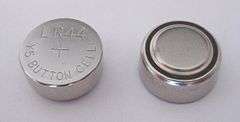LR44 battery

LR44 is the IEC designation for an alkaline 1.5 volt button cell, commonly used in small LED flashlights, digital thermometers, calculators, cameras, calipers, watches, clocks, toys, multimeters, and laser pointers.
The battery nomenclature is defined by the International Electrotechnical Commission (IEC) in its 60086-3 standard (Primary batteries, part 3 Watch batteries). The letter "L" indicates the electrochemical system used: a zinc negative electrode, manganese dioxide depolarizer and positive electrode, and an alkaline electrolyte. "R44" indicates a cylindrical ("round") cell 11.4±0.2 mm diameter and 5.2±0.2 mm height.
Alternative designations
Manufacturers have their own part numbers for IEC type LR44 batteries including:
- LR44, LR44G, LR44GD, LR44H
- LR1154, L1154, L1154C, L1154F, L1154G, L1154H
- 6135011748057 (NSN)
- 1166A (part number)
- AG13, A613, AG14, AG-14, G13A, G13-A
- 157, 303, 357
- A76, AG76, GDA76, GP76A, GPA7, GPA75, GPA76, GPS76A,
- 1128MP, 208-904, A-76, CA18, CA19, CR44, D76A, KA, KA76, MS76H, PX76A, PX675A, RPX675, RW82, SB-F9, V13GA

Other batteries of R44 size
Other types of batteries are or were made in the R44 physical size. Formerly, mercury batteries were made as button cells (types MR44 and NR44). Zinc-air batteries type PR44 require exposure to the air to operate. Some hearing aids[1] and budget solar garden lamps contain a rechargeable 40mAh battery with Ni-MH chemistry. While having the same dimensions,[2] these have a nominal voltage of 1.2V, as with many NiMH batteries. They are compatible with many devices that were designed for LR44 batteries, but some devices may not function properly due to the lower voltage. Silver-oxide batteries type SR44 may provide extra capacity compared to LR44 types but have slightly different voltage characteristics. Performance of a device meant to use a silver-oxide battery may be degraded with substitution of alkaline types.
Obsolete light meters originally designed to use mercury batteries will give false readings with substitution of LR44 alkaline types. Fortunately some manufacturers provide proper adapters to solve this problem.
Manufacturer's numbers for silver oxide R44 size cells include:
- SR44, SR44W, SR44SW
- 6135-99-651-3240 (NSN)
- SR1154
- 1107SO
- 1131SOP
- SG13
- S76
- EPX76 (Energizer)
- 303, 357 (D357H, V357)
Comparison of R44 types
| IEC name | ANSI/NEDA name | Typical capacity (mAh) | Nominal voltage (V) | |
|---|---|---|---|---|
| Alkaline | LR1154, LR44 | 1166A | 150 | 1.50 |
| Silver oxide | SR1154, SR44 | 1107SO | 200 | 1.55 |
| Mercuric oxide (withdrawn) |
MR1154, MR44 | 210 | 1.35 | |
| Zinc–air battery | PR44, PR675 | 600 | 1.35 or 1.40 |
Installation, use and safety
While the cell is not totally symmetric, in most applications care is needed to install the cell with the correct electrical polarity. Some manufacturers advise wiping the cell with a cloth prior to installation, and to avoid handling the parts in electrical contact with the appliance, because dirt, acid, moisture, and oils from the skin can impair the electrical conductivity of the connections.
In general, these cells are primary cells, not designed to be recharged.
Short circuiting a cell can cause an explosion, as the high short circuit current overheats the cell due to internal resistance.[3] Other forms of overheating, such as fire can also cause explosions.
Cells may be swallowed by small children, and present a choking risk. Some chemistries can also cause severe internal burning, or poisoning, leading to fatalities.[4] Burns have also resulted from cells placed in the nose or ear.
See also
- Battery recycling
- List of battery sizes (including SR/LR series batteries)